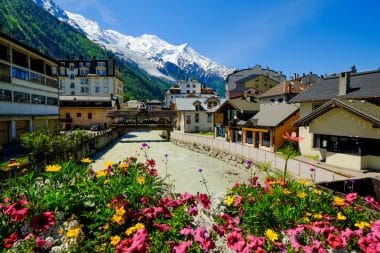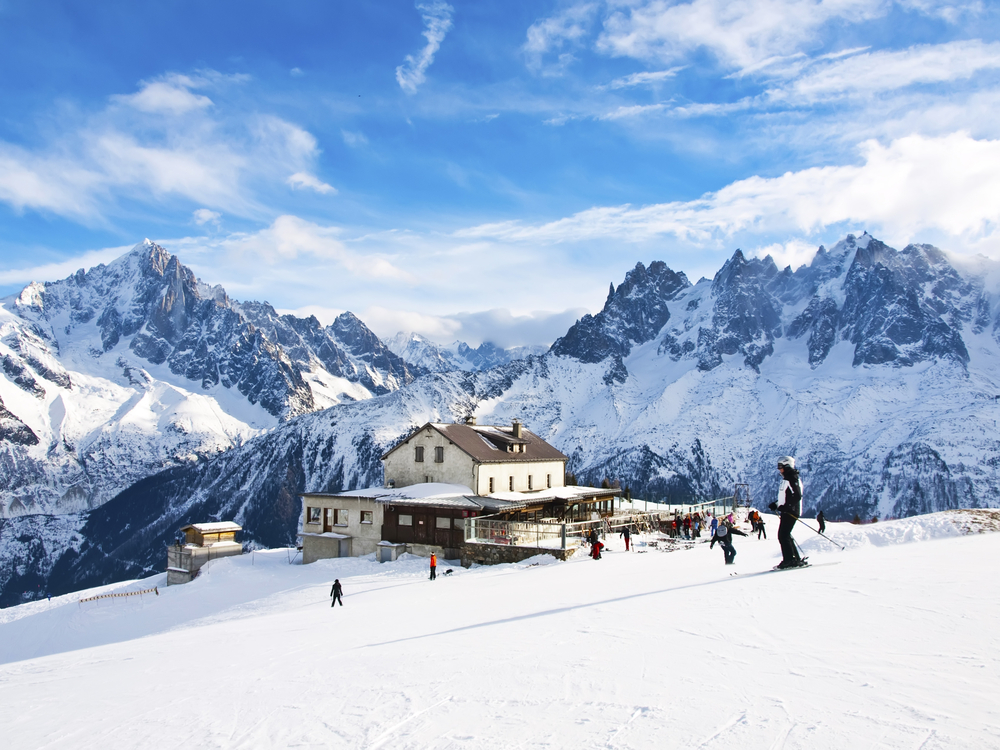Chamonix is located at the foot of the highest mountain in Europe, Mont Blanc with its 4,810 meters altitude. It is therefore not surprising that both alpinists and winter sports enthusiasts appreciate the French town, which is officially called Chamonix-Mont-Blanc. It is not far from the Swiss and Italian borders. There are numerous high peaks around Chamonix, which turn the Chamonix valley into a distinct ski area in winter. Chamonix was the first venue for the Winter Olympics, which were held there in 1924.
Chamonix includes several other places, including
- Argentière
- Le Bossons
- Le Lavancher
- Les Praz
- Les Tines
- Le Tour
Insights and views at the Aiguille du Midi
The size of the valley with the various villages offers passionate skiers and beginners a variety of different ski areas. A total of 110 kilometres of slopes await winter sports enthusiasts here. These are divided into several ski resorts, which are networked by trains and buses. In addition, the “Télépherique” cable car goes up to the mountain “Aiguille du Midi”, which has an altitude of 3,842 meters. There, panoramic terraces await you at a vantage point that is one of the most popular in the Alpine massif.
The cable car starts directly in Chamonix at an altitude of 1035 meters and uses two different sections. After its middle station, there are no more intermediate supports. The rope freely overcomes the difference in altitude of 1,467 meters up to the terminus, which is a masterful technical achievement. There, skiers get off at the highest cable car station in all of Europe. You will then go on the longest glacier descent on the European continent, the “Vallée Blanche”, which stretches 24 kilometres down to the village if the snow and weather conditions are right.
However, visitors to the Aiguille du Midi should first enjoy the view from the various visitor terraces. They are connected by a circuit, the “Tube”, which opened in 2016. It connects the different viewing terraces with each other and thus leads around the central summit at an altitude of 3,700 metres. This opens up a view of various peaks over 4,000 metres above sea level, including Mont Blanc. These mountains are located in France, as well as in Italy and Switzerland. Another experience on the Aiguille du Midi is the Skywalk, which is attached to one of the terraces. The small glass cabin hangs 1,000 meters above the bottom of the valley and offers visitors a special thrill and unforgettable photos.
The best ski resorts in the Valley of Chamonix

The largest ski area in Chamonix is the one in Flégère/Brévent, with a total of 56 km of slopes. This is also where most of the black slopes are located, which are suitable for the advanced skiers, a total of 20 kilometers. This ski area is located at an altitude of between 1000 and 2500 meters and has 17 cable cars and lifts. At a similar altitude, between 1,000 and 1,900 meters, is Saint-Gervais/Les Houches. It uses the slopes of the Prarion and Bellevue mountains.
With 55 km of slopes, this ski area is hardly inferior to that of Brévent. Snowboarders also get their money’s worth here. The majority of the runs here are suitable for beginners and advanced skiers. If you are looking for a challenge, you will find it on the route of the Alpine World Cup, the “Kandahar”. If you want to do sports in other ways, you can do so cross-country skiing on a total of 50 km of trails. The area can also be explored on snowshoe hikes or a paragliding flight. With 11 km of beginner and 25 km of advanced slopes, everyone gets their money’s worth here.
Nostalgic charm on the Arctic Ocean
On the outskirts of Chamonix, there is a means of transport that brings a certain nostalgia, the “Train du Montenvers”. It is one of only two railways of its kind left in France. Visitors can take this train to Montenvers. Once you arrive at an altitude of 1,913 metres, the view of the “Mer de Glace” glacier, France’s largest glacier, awaits. With a length of about 12 kilometres and a total area of 32 square kilometres, the “Eismeer” is also the fourth largest glacier in the entire Alpine massif. If you don’t shy away from the effort of 550 steps, you can descend to the ice grotto here. This opens up special insights into the glacier. On the Montenvers, you can visit the Crystal Gallery, which exhibits impressive crystals from the Mont Blanc massif.
One village, one valley, many possibilities – Chamonix in summer

Chamonix, with its less than 9,000 inhabitants, is a small town with French flair. In addition to the usual shops, bars and restaurants, there is also a town hall worth seeing and St. Michel, the small church of the village. The river “Arve”, fed by the glaciers in the area, flows in its milky hue through the middle of Chamonix. The place, often affectionately called “Cham”, is considered the birthplace of modern alpinism. Even in summer, countless visitors come to the village to do free climbing on the rock faces, to descend slopes on their mountain bikes or to glide down from the peaks through the air in a flight suit, the “wingsuit”. Every year, the “Ultra-Trail” attracts 2,300 mountain runners to Mont Blanc, who overcome 170 kilometres with 10,000 metres of altitude difference – in a time limit of 46 hours. Even not so passionate mountain runners will find 18 different trails in the valley of Chamonix. Those who prefer hiking can choose between numerous day hikes of varying difficulty, from easy to challenging


